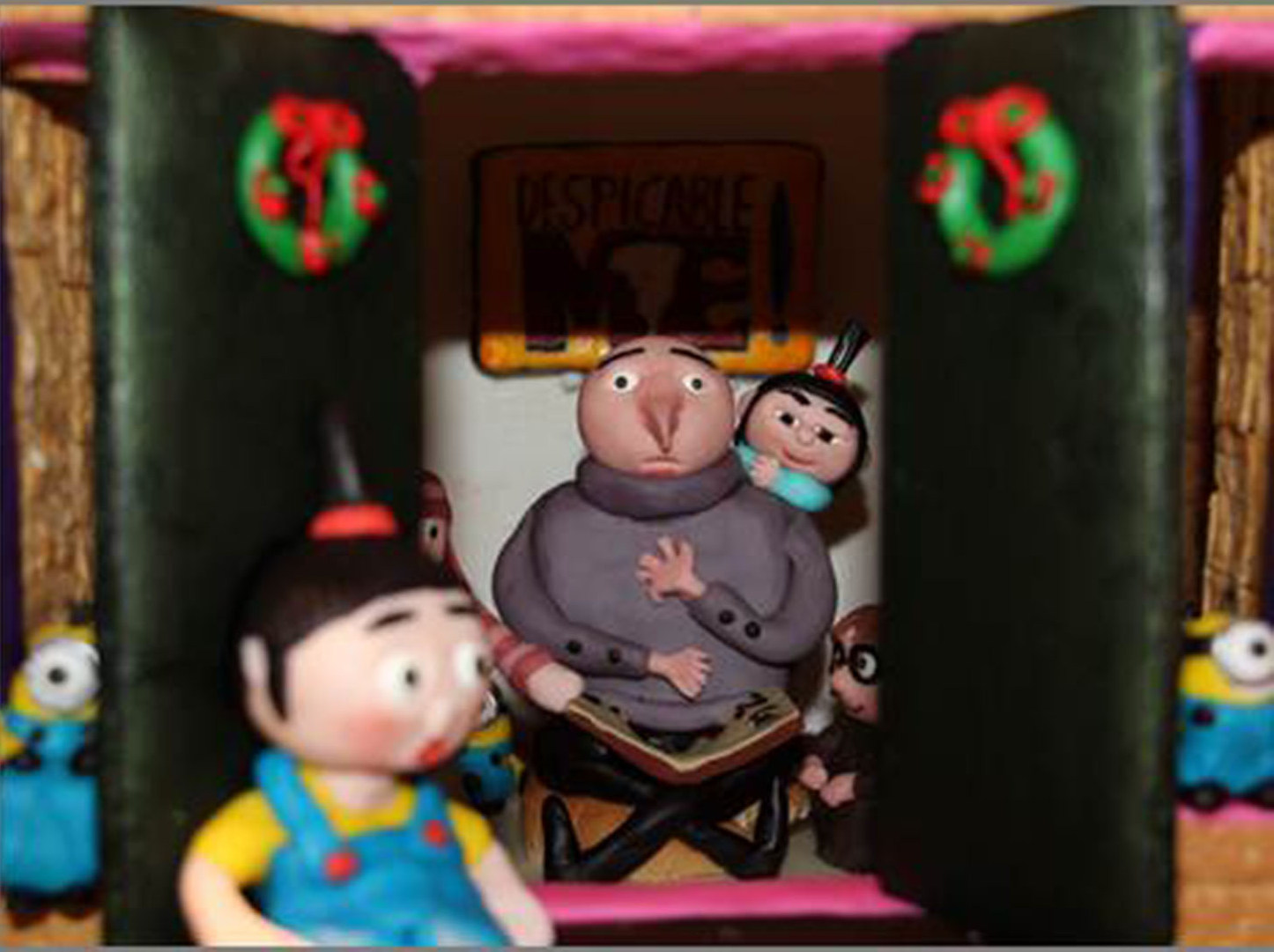

January 2014
IN THIS ISSUE:
![]()
- Gates visits NIH, describes initiatives to reduce child death rate during a Global Health Lecture
- Dual TV/tablets installed in patient rooms
- Wife of Alzheimer's patient finds hope at CC, speaks of caregivers' pivotal role
- Connecting caregivers to resources
- Patient photographer shares snapshots of hospital's history
- Stand up for what you believe in, says Pizzo
- 2014 Leadership Development Brown Bag Series kicks off Jan. 22
- NIH research festival focuses on advances and scientific opportunities
- Clinical Center facilities manager retires after four decades at NIH
Print this Issue ![]() (354 KB)
(354 KB)
ABOUT CC NEWS:
![]()
Published monthly by the Office of Communications and Media Relations. News, article ideas, calendar events, letters, and photographs are welcome. Submissions may be edited.
Clinical Center News
National Institutes of Health
Building 10, 10 Center Drive
Room 6C-420,
Bethesda, MD 20892-1504
Tel: 301-594-5789
Fax: 301-402-4984
PAST ISSUES:
![]()
2013
QUICK LINKS:
![]()
2013 Gingerbread House Contest Winner
3NE's Despicable Me cottage is the 2013 Gingerbread House Contest winner. More than 5,400 votes were placed online and in person Dec. 2-15. The houses are on display in the CC atrium until Jan. 6. View all 49 entries on our Facebook photo album.[disclaimer]
Gates visits NIH, describes initiatives to reduce child death rate during a Global Health Lecture
 |
Bill Gates, business entrepreneur and philanthropist, and Dr. Francis S. Collins, NIH director, address health questions in Masur Auditorium. |
In the 1960s, worldwide 20 percent of all children died before their fifth birthday. Today, roughly 5 percent of all children die before age 5. In fifteen years, Bill Gates hopes to see that percentage drop below 3 percent.
Gates, Microsoft Chairman and co-chair of the Bill and Melinda Gates Foundation, reviewed the progress that has been made in improving people's health around the world and outlined the challenges remaining to improve global health in his talk for the David E. Barmes Global Health Lecture on Dec. 2. Gates' visit to NIH began with a stop at the C.W. Bill Young Center, where he met with researchers to discuss tuberculosis vaccine development. It continued with a meeting with NIH senior leadership and ended with the lecture in Masur Auditorium.
Gates and his wife, Melinda, established the Gates Foundation in 2000. Gates decided to focus on global health after he and Melinda read a New York Times article that said 250,000 children died from rotavirus, the most common cause of diarrhea. Left untreated, rotavirus causes severe, often fatal, dehydration.
"We said, 'wow, there is a lot of low-hanging fruit where these lives are not being treated as equal,'" Gates said. "In fact, we're allowing children to die, where just spending a few thousand dollars to raise vaccine coverage or to introduce a new vaccine would save these lives."
Since he and his wife established the Gates Foundation in 2000, the foundation has worked to distribute vaccines to children in the world's poorest countries.
"The effect of vaccines is truly marvelous," Gates said. "Over time, the cost of making most vaccines will get down to something like 20 to 25 cents per child treated. And yet, it can give you life-long protection." Gates said that such widespread vaccination campaigns are possible because of NIH's commitment to basic science.
As an example, he cited Intramural scientists Dr. John Robbins and Dr. Rachel Schneerson's work on developing a vaccine for Hemophilus influenzae type b (Hib), the leading cause of bacterial meningitis. Before the vaccine was developed Hib was once the leading cause of acquired mental retardation. Now, Hib infection is virtually unknown in the developed world.
Gates identified polio as a disease he hopes to eradicate by 2018. The foundation is focusing on Nigeria, Pakistan and Afghanistan. Although polio was eradicated in many parts of the world, these three countries continue to see outbreaks. To meet this goal, health workers are using satellite maps and GPS trackers to pinpoint the location of villages in remote areas where children haven't been vaccinated.
"It's doable, but it's an amazing enterprise that requires dedicated workers, funding and innovation," Gates said.
If polio eradication efforts are successful, Gates hopes to shift attention to protecting children from other diseases, like malaria and tuberculosis. He also recognized the importance of reducing the mortality rate of babies younger than a month old. He invited NIH to work with the Gates Foundation to understand what happens in the first 30 days of life.
"Investing in research has huge paybacks—paybacks in improving the human condition and paybacks in reducing health costs as you get new tools," Gates said.
View the lecture: http://go.usa.gov/ZCa9.
Dual TV/tablets installed in patient rooms
 |
Patients will be able to access apps such as Fruit Ninja, Candy Crush, Angry Birds space, Family Feud, and much more. |
The Clinical Center, together with a communication systems manufacturer, developed from prototype to production the first set of hospital-grade Android TVs that provide users access to movies, email, internet, games and apps in addition to existing TV stations.
The 260 state-of-the-art bedside entertainment systems being installed in the hospital are a cost-effective way to replace computers and TVs in patient's rooms that are approaching the end of their useful life. Devices are currently mounted in 1NW and will be added in patient care units on the third, fifth and seventh floor by spring 2014.
Similar to many smart phones, with the touch of a finger, users can interact with support groups at home through email and social media, watch the latest movies and TV shows or engage in friendly competition with a companion located miles away through gaming apps. The wireless devices assure quick and easy online access and the touch screen will help reduce clinical staffs' time locating a keyboard or mouse.
"When this hospital was opened in 2005, it was one of the first to have bedside computers for all of our inpatients," said Denise Ford, director of patient and guest relations.
"Eight years later, as technology has changed and devices have grown faster and smaller, the hospital is taking a technology savvy step to providing the utmost patient experience."
The 14-inch tablet, only weighing about 7 pounds, is made from a special antimicrobial glass that can be wiped clean between patients. Every new patient that checks in creates an account and the first time they sign-in the device will automatically eliminate any past data or personal identifying information.
Donna Gregory, chief of recreation therapy in the rehabilitation medicine department, anticipates the new devices will be very therapeutic'.
"Because most of our patients come from a distance and stay for a long time, it's really important for them to stay connected with their support networks back home. A lot of patients have to stay in their room or be in bed a significant portion of their time, and this gives them an opportunity to engage in something meaningful to them," Gregory said. "This technology is going to greatly improve patient's quality of life while they're here."
The devices are expected to save the CC $300,000 initially and a minimum of $100,000 annually in computer support costs moving forward.
Wife of Alzheimer's patient finds hope at CC, speaks of caregivers' pivotal role
 |
Jim and Karen Garner |
Many patients come to the Clinical Center in hopes of finding healing through experimental treatments or cures. That is what Karen Garner hoped for her husband, Jim, when he began to experience mild cognitive impairment, or MCI, at only 48 years of age. Because Alzheimer's disease ran in Jim's family, Karen wanted to be proactive.
"The Alzheimer's Association suggested that I go to clinicaltrials.gov, so I did," Karen says. "I really wanted to get him into a clinical trial of the newest, latest drugs. But because of his age, he was too young."
Jim wasn't able to join a clinical trial, but he did enroll in a diagnostic study taking place at the Clinical Center. Dr. William Kreisl and his team at the National Institute of Mental Health have developed a brain scan test that may be helpful for detecting the conversion from MCI to Alzheimer's disease.
"Inflammation appears to play an important role in the damage that occurs in Alzheimer's disease," Kreisl explains. "The results from our study suggest that inflammation increases during the conversion of MCI to Alzheimer's disease dementia and continues to increase as the dementia gets worse. We are hopeful that this type of technology could one day help evaluate the effectiveness of new treatments for Alzheimer's disease."
"It makes you feel like you're doing something for the greater good. We do a lot of advocacy work; I write a blog that has garnered a lot of attention, and we do a lot of interviews," Karen says. "That's great for educating people, but when it comes down to the day-to-day grind of trying to find a cure, trying to find treatments at least, and to understand the disease, this is where we feel like we're actually, truly making a difference and really stepping up to the plate."
Alzheimer's disease affects the whole family, especially the primary caregiver. Though Jim is in the early stages of the disease, "knowing what's coming down the pike—the mental and emotional stress of that is overwhelming and daunting," Karen says. On the societal level, she adds, "I think respite care needs to be looked at. The caregiver is overwhelmed long before hospice comes into play, and caregivers end up with medical problems because of all the stress. Too many people are trying not to let other people see how difficult this journey is. I think the more people understand, the more help will become available."
Asked what friends can do to help, Karen says, "just not disappearing from their life. Just saying, I've missed you, can we go for a walk, can I come over and help you cook dinner, can I come over and help you weed your yard while we talk?'"
The Garners are full of praise for the treatment they've received at NIH. "The Clinical Center is not like any other hospital. NIH tracks you to make sure you get what you need," says Jim.
And Karen adds, "realizing that there are so many people working on a cure, I just want to say thank you, thank you, thank you! Please don't give up."
Connecting caregivers to resources
 November has been nationally recognized as Family Caregiver Month since 1997. The CC hosted its 4th annual Family Caregiver Day Nov. 21 to celebrate the month.
November has been nationally recognized as Family Caregiver Month since 1997. The CC hosted its 4th annual Family Caregiver Day Nov. 21 to celebrate the month.
The informational fair and expo featured representatives from multiple departments, the National Institute of Aging, the NIH Patient Library, the National Institute of Mental Health as well as local and national caregiver resource organizations. Information available included nutritional health, mental health, stress relief, relaxation techniques and caregiver resources.
Participants could take part in activities such as art projects, a nature walk, meditation and massage. The event was a reminder to caregivers to care for themselves too.
According to a 2009 report by the National Alliance for Caregiving, 65.7 million people care for a chronically ill or elderly family member or friend each year. Studies have shown the caregiving experience can be a chronic stressor that can negatively affect a caregiver's life.
In 2005, the CC began researching the effect of caregiving, said Cmdr. Margaret Bevans, a U.S. Public Health Service nurse investigator with the Nursing Department.
"The goal of the research is to expand our understanding of caregivers' needs and to develop targeted programs and resources for them. This annual event is a translation of the current evidence into our practice at the NIH Clinical Center," Bevans said.
It connects caregivers with the resources to help them, she added.
"You have to take care of yourself so that you can take care of your loved one. It is easy to forget that," said Karen Marshall, who ran one of the booths. She was a caregiver for both her parents and as a result of that experience started a nonprofit organization to help other caregivers.
"Today is about connecting caregivers with the available resources and telling them that we think they are special. We want to offer them resources to make their experience easier," said Cmdr. Leslie Wehrlen, a U.S. Public Health Service research nurse with the Nursing Department.
View NIH caregiver resources: http://go.usa.gov/ZxJW.
![]()
Patient photographer shares snapshots of hospital's history
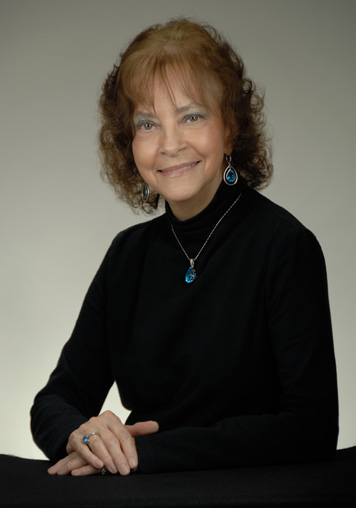 |
Mary King |
Mary King has worked at the NIH for more than 51 years. She served as a patient photographer at the CC from November 1981 until her retirement this month. King shared her memories with CC News in November 2013.
The Clinical Center hospital facilities for the patients have really changed. The new patient rooms are bright and cheerful compared to the old patient rooms. In the old hospital, patients had to go down the hall to use one central telephone to call their families. The new rooms now have computers and telephones.
This is a wonderful place to work. It really is. I've been photographing some patients from the time they were kids and now they're adults. So you learn their history, and while you photograph them, you listen.
I learned photography on the old NIKON F cameras, the ones where you had to take the back off, load the film and put the back on. Then we went to the automatic/manual setting cameras, which I didn't trust to give me the correct settings, and then to the early digital cameras. The first digital camera we purchased for Patient Photography was the Fujix/Nikon 1.3 megapixel camera. It was heavy and was only 1.3 megapixels. The images were horrible. Going from film to digital was a big change.
Read more reflections at our 60th anniversary website: http://go.usa.gov/ZZ3Q.
Stand up for what you believe in, says Pizzo
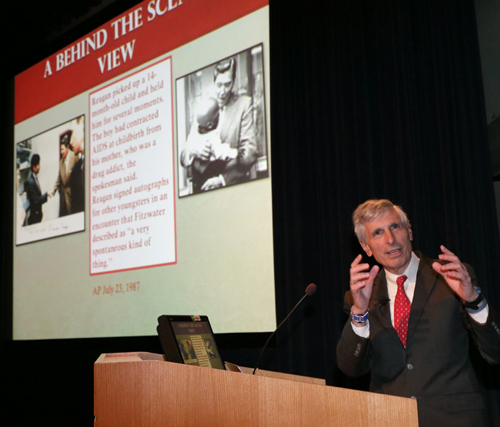 |
"NIH to me was and still is the most important part of my own career," said Dr. Philip A. Pizzo, who has served as dean of the Stanford University School of Medicine and chair of the Department of Pediatrics at Harvard Medical School. |
Many people know Dr. Philip A. Pizzo as the doctor who handed a baby with HIV to President Ronald Reagan. Others know him as the advocate who helped found The Children's Inn at NIH. Few, however, know the stories behind the headlines.
A former chief of the National Cancer Institute's (NCI) Pediatric Branch and its infectious diseases section, Pizzo recounted how NIH's unique commitment to basic science and patient-centered care shaped his career in the Contemporary Clinical Medicine: Great Teachers lecture held in Lipsett Amphitheater Nov. 13.
Pizzo began his career at NIH in 1973 as a fellow in the pediatric oncology branch at NCI. Early in his career, Pizzo met Ted DeVita, a young patient with a rare but serious blood disorder, severe aplastic anemia, which prevented his body from producing new blood cells. DeVita's condition forced him to live in protective isolation until his death in 1980. During his time with DeVita, Pizzo learned a lot about aplastic anemia.
"I learned another lesson from his sister after he died," Pizzo said. "I realized the impact of death and dying on siblings of individuals who we can easily take for granted."
In 1980, Pizzo became chief of NCI's Pediatric Branch. Soon after, patients with HIV/ AIDS came to the Clinical Center.
"I made the decision that this was an area that we needed to get involved in," Pizzo said. "It took tenacity and persuasion to convince people to do it."
As the life cycle of the virus became known, Pizzo turned his attention to developing treatments for HIV/AIDS pediatric patients. At first, he faced opposition. Then, adult patients enrolled in clinical trials. Only after the adult trials began could children participate in clinical trials.
Pizzo didn't accept that view.
"If you care about something and you have the data to support it, stand up for it," said Pizzo.
He persuaded drug companies to manufacture pediatric antiretrovirals for children and the United States Food and Drug Administration to fast track the pediatric retroviral approval process.
Around this time, President Reagan visited NIH to announce the formation of the Presidential Commission on the HIV epidemic. His visit included a tour of the pediatric unit. As the visit wound down, Pizzo picked up a baby with HIV and gave it to Reagan (seen in the foreground of the image above). The next day, the newspapers published photographs of Reagan holding the child. "After this, some of our scientific reports were published, and we were beginning to get some acknowledgement in the literature and the press on what was happening," Pizzo said.
Pizzo's advocacy extended beyond expanding access to HIV/AIDS treatments. For years, Pizzo asked about building a house for pediatric patients and their families to stay during treatment. Nothing happened until Pizzo met Carmela Walgren, Congressman Doug Walgren's wife, through a Clinical Center patient. Walgren learned of the need for a children's home at NIH. Construction on The Children's Inn began shortly after.
He left NIH in 1996 to become physician-in-chief and chair of medicine at Boston Children's Hospital and professor and chair of pediatrics at Harvard Medical School. Five years later, he was appointed dean of the Stanford School of Medicine.
"NIH to me was and still is the most important part of my own career," Pizzo said. "There has not been an environment in my life more formative and more important than this institution."
To see the entire Grand Rounds, visit: http://go.usa.gov/WMye.
2014 Leadership Development Brown Bag Series
kicks off Jan. 22
The Office of Workforce Management & Development's first session, Using Self- Awareness to Appreciate & Manage Differences, will be held in the Medical Board Room (4-2551) at Noon. Details for staff: http://intranet.cc.nih.gov/owmd/index.html (NIH Staff Only).
NIH research festival focuses on advances and scientific opportunities
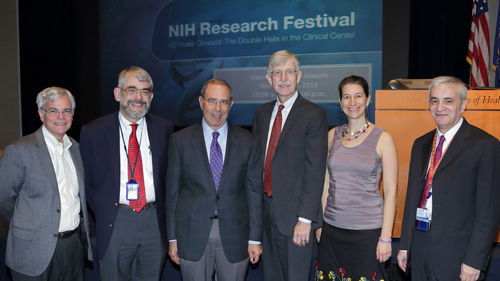 |
Dr. Michael Gottesman, NIH deputy director for Intramural Research; Dr. Daniel Kastner, scientific director of the National Human Genome Research Institute (NHGRI) and festival co-chair; Dr. John I. Gallin, Clinical Center director; Dr. Francis S. Collins, NIH director; Dr. Julie Segre, senior investigator at NHGRI; Dr. Luigi Ferrucci, scientific director of the National Institute on Aging and festival co-chair. |
Since 1986, the NIH has held a Research Festival to highlight significant biomedical advances made. This year, for the first time, it was held entirely in the NIH Clinical Center.
In his remarks at the opening plenary session, Dr. Francis S. Collins, NIH director, called the 1953 discovery of the double helix "the most significant discovery of the twentieth century." He also quoted Oveta Culp Hobby, the first Secretary of Health, Education and Welfare, who spoke at the dedication of the original Clinical Center, which at the time was the biggest brick building in the world.
"By this joining...of hospital, clinic and research laboratories...scientists are acquiring a new and powerful tool in their endless struggle to unlock the stubborn secrets of disease and build a better life for all of us," Hobby said.
Dr. John I. Gallin, Clinical Center director, gave a brief summary of the hospital's history, highlighting some of the scientific advances made here in the past 60 years and noted its reputation for excellence, particularly in patient care, phenotyping, drug development, data management and transfusion medicine.
Dr. Julie Segre, National Human Genome Research Institute (NHGRI) senior investigator spoke to the audience about how she, along with her colleagues Drs. Evan Snitkin, Tara Palmore and David Henderson, earned this year's Federal Employees of the Year award for their breakthrough in tracking and controlling a cluster of antibiotic-resistant bacterial infections at the Clinical Center.
The opening session ended with a lecture by Dr. Cynthia Dunbar, senior investigator in the National Heart, Lung and Blood Institute, who spoke about "The NIH: A Supportive Niche for Translational Stem Cell Research."
Throughout the festival, lectures, symposia, and poster sessions, offered researchers the opportunity to network and gather information about available resources. There were also guided tours of the Clinical Center and of the Office of NIH History exhibits.
The festival was co-chaired by Dr. Luigi Ferrucci, scientific director of the National Institute on Aging, and Dr. Daniel Kastner, scientific director of NHGRI.
Kastner called the double helix and the Clinical Center "the double cornerstones of my career and of many of our careers."
The partial government shutdown postponed the festival from Oct. 9-12 to Nov. 6-8.
View a videocast of the opening ceremony: http://go.usa.gov/ZxtQ.
Academic center opens During the research festival, a ribbon cutting celebrated the official opening of the Foundation for Advanced Education in the Sciences Academic Center (FAES). Dr. Angela Gronenborn, FAES board president, thanked NIH "for being our partners" and expressed confidence that this new educational facility would "be filled with the minds of the brightest and the best." On behalf of NIH, Dr. Collins expressed "sincere gratitude [to FAES] for this space, and for raising the $10 million it took to build it." He added, "over the past 50 years FAES has thought of many creative ways to enhance and support the work that is going on here." Dr. Edwin "Ted" Becker, past director of the NIH Office of Research Services, past president of FAES, and scientist emeritus in the National Institute of Diabetes and Digestive and Kidney Diseases, was presented with a plaque honoring him for his efforts to help move the dream of an academic center, ten years in the making, toward reality. In accepting the plaque, Becker noted that it was Dr. Michael M. Gottesman, NIH deputy director for Intramural Research, who convinced the FAES Board that there was a need for the Clinical Center's many graduate students to have a place to attend lectures, and congregate. |
Clinical Center facilities manager retires after four decades
at NIH
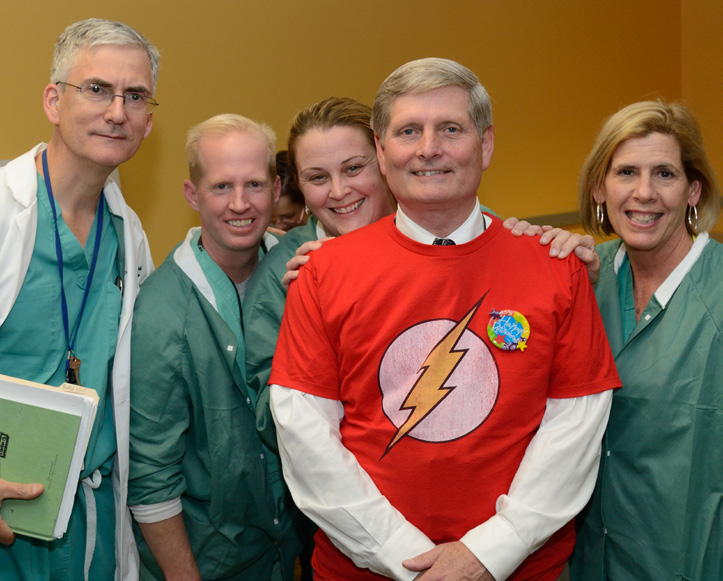 After more than 40 years at NIH, Fred Manuel (second from right), Clinical Center facilities manager, celebrated with colleagues and friends at a retirement party Nov. 13. "This is an amazing place to work," Manuel said. "You never know who's going to get the next Nobel Prize, or some special science award. I like to know that I'm here helping the patients. If I ever see anybody that looks like they're puzzled, I try to make them feel welcome. I'm going to miss working here."
After more than 40 years at NIH, Fred Manuel (second from right), Clinical Center facilities manager, celebrated with colleagues and friends at a retirement party Nov. 13. "This is an amazing place to work," Manuel said. "You never know who's going to get the next Nobel Prize, or some special science award. I like to know that I'm here helping the patients. If I ever see anybody that looks like they're puzzled, I try to make them feel welcome. I'm going to miss working here."
NOTE: PDF documents require the free Adobe Reader.
 The information on this page is archived and provided for reference purposes only.
The information on this page is archived and provided for reference purposes only.

